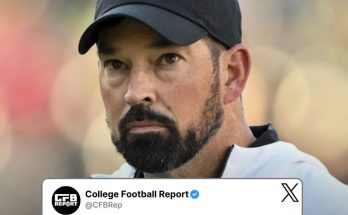Florida State University has always been a program that prides itself on tradition, loyalty, and the bond between the team and its supporters. For decades, the Seminoles have relied on their faithful fans to fill Doak Campbell Stadium with a sea of garnet and gold, creating one of the most recognizable and intimidating environments in college football. Yet among the thousands who have cheered from the stands, one name has risen as a symbol of unparalleled devotion: Griff Godfrey. This year, Florida State chose to honor Godfrey, who holds the incredible distinction of being the longest-living season ticket holder in program history, having supported the team for an astounding 76 consecutive years. His story is not only one of longevity but also of passion, community, and the unique spirit of college athletics.
Griff Godfrey’s journey as a fan began in the post-war era when college football itself was undergoing significant transformation. The Seminoles were still in their developmental years as a program, striving to establish themselves among the giants of the sport. For a young Godfrey, who had just begun to fall in love with the energy of the game, it was the start of a relationship that would span generations. To understand his loyalty is to recognize how college football is not just about wins and losses but about identity, memory, and shared experiences that become a part of who a person is. Over the decades, Godfrey watched the Seminoles evolve from a modest program to a powerhouse of national prominence, collecting three national championships, producing legendary players, and securing a permanent place in the conversation of college football greatness. Through every era, through the highs of championship seasons and the lows of rebuilding years, his seat was never empty.
When Florida State decided to honor him publicly, it was about more than just recognizing a milestone of 76 years as a season ticket holder. It was about paying tribute to what he represented. Fans like Godfrey are the lifeblood of college sports. They embody the continuity of tradition, linking the past with the present. They are the ones who teach new generations about the pride of wearing garnet and gold, the meaning of the war chant, and the goosebumps that come with hearing the Marching Chiefs lead the crowd. Godfrey’s presence over nearly eight decades made him a living archive of Seminole history. He could recall the first time Bobby Bowden took the sidelines, the unforgettable moments when Charlie Ward dazzled with his Heisman-winning season, and the relentless grit of Jameis Winston leading the team to the 2013 national championship. His memory is the program’s memory, and that is what makes his story extraordinary.
As part of the recognition, Florida State presented Godfrey with a commemorative plaque during a pregame ceremony, with fans and players alike rising to applaud him. The moment served as a reminder of how interconnected the Seminole family is. It was not just about a single man sitting in the stands but about how his dedication symbolized the loyalty of thousands of others who follow the team year after year. In honoring him, Florida State also honored the essence of fandom itself. The response from the community was overwhelming, with fellow fans sharing their stories of seeing Godfrey at games, exchanging smiles and handshakes, and marveling at how consistently he represented what it meant to be part of the Seminole tribe.
What sets Godfrey apart is not only his consistency but also his adaptability. College football has undergone massive changes during his 76 years as a ticket holder. The sport went from limited regional exposure to nationwide broadcasts, from hand-written tickets to digital passes scanned at turnstiles, from modest stadium expansions to the mammoth structures we see today. Through all of these evolutions, Godfrey adjusted but never wavered. He witnessed the rise of television contracts, the realignment of conferences, and even the introduction of the College Football Playoff. To him, the changes were part of the sport’s natural growth, but the core remained the same: supporting the team, rain or shine, win or lose. That steadfastness is what makes him more than just a fan but a symbol of resilience and faith in the institution he loves.
The recognition of Griff Godfrey also provided an opportunity to reflect on the significance of season ticket holders in general. While casual fans may tune in occasionally or catch highlights online, it is the season ticket holders who provide the beating heart of the stadium atmosphere. They are the ones who arrive early, who tailgate in the parking lots, who teach their children the chants, and who transform the stadium into a fortress. They create continuity across generations. Florida State understood this when honoring Godfrey; he was not only being celebrated as an individual but as the embodiment of an entire culture of loyalty that sustains the program.
What makes his story even more impactful is the generational legacy that often comes with such dedication. Many families who have held season tickets for decades pass them down like heirlooms, creating traditions that outlast lifetimes. Godfrey himself has seen children, grandchildren, and great-grandchildren grow up within the walls of Doak Campbell Stadium, experiencing the thrill of Seminole football just as he first did decades ago. In many ways, his 76 years represent a family legacy intertwined with Florida State football. His life story has become inseparable from the history of the team itself.
The celebration of his loyalty comes at a particularly important time for college athletics, when questions of commercialization, conference realignment, and shifting playoff formats dominate discussions. In such a climate, Griff Godfrey’s unwavering devotion stands as a reminder of what college football is truly about: connection, tradition, and community. For him, the game was never about media deals or playoff rankings. It was about showing up for his team, regardless of the circumstances, and finding joy in the shared passion of fellow fans. That message resonates powerfully, especially in an era when loyalty is often tested by external pressures.
Florida State’s recognition also carried an educational message for younger fans. In a world of instant gratification and fleeting allegiances, Godfrey’s 76 years of consistency highlighted the beauty of sticking with something for the long haul. His story teaches that loyalty is not just about supporting a team when it is at the top of the rankings but about embracing every chapter, even the difficult ones. It reinforces the idea that the identity of a fan base is shaped not only by the triumphs but also by the perseverance during challenging times.
As the Seminoles move forward into a new chapter of their football history, with renewed ambitions of reclaiming national championships and maintaining their legacy, the figure of Griff Godfrey will remain a source of inspiration. His name will be remembered not only for the years he held season tickets but for what those years meant to the community. He showed that being a fan is not just about entertainment but about identity, belonging, and love for a cause larger than oneself.
The public tribute was also deeply personal for Godfrey, who expressed his gratitude not only to the university but to the fans around him. For him, every game day was more than just football; it was about reconnecting with friends, neighbors, and the Seminole family. He cherished the collective experience of cheering together, of celebrating victories, and of mourning losses as a community. That sense of belonging, more than any scoreboard, is what kept him returning to the stands for 76 consecutive seasons.
Florida State has a rich history of legendary figures: coaches like Bobby Bowden, players like Deion Sanders and Jameis Winston, and iconic traditions like Chief Osceola and Renegade charging across the field. Now, in its own way, Griff Godfrey stands among these legends—not for what he did on the field but for the steadfastness with which he supported those who did. His recognition cements him as part of the lore of Seminole football, a reminder that the story of a program is not written solely by those who play the game but also by those who watch it with unwavering devotion.



